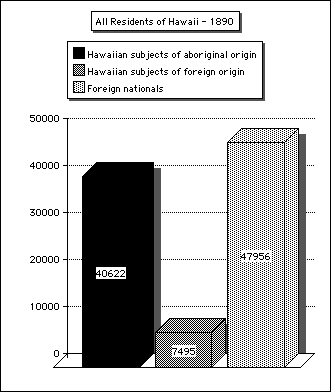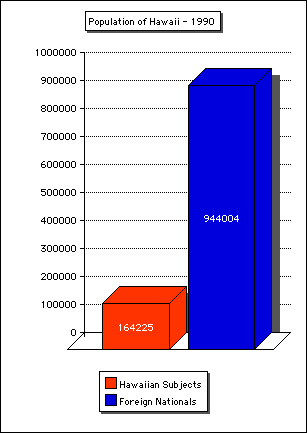HAWAIIAN SUBJECTS IN THE ISLANDS
ESTIMATED AT A MINIMUM 164,225
The Polynesian
October 2000
 In order to arrive at some estimation as to the population of Hawaiian
subjects presently residing in the islands today, all that's needed is to
take the last census report in the Kingdom, being 1890, and compare it with
the latest U.S. census in 1990, one hundred years later. Here we would be
able to develop an increase factor to estimate the number of Hawaiian
subjects (both aboriginal and non-aboriginal) presently in the islands as
compared to the foreign national population.
In order to arrive at some estimation as to the population of Hawaiian
subjects presently residing in the islands today, all that's needed is to
take the last census report in the Kingdom, being 1890, and compare it with
the latest U.S. census in 1990, one hundred years later. Here we would be
able to develop an increase factor to estimate the number of Hawaiian
subjects (both aboriginal and non-aboriginal) presently in the islands as
compared to the foreign national population.
According to the 1890 census it listed the population at 96,073. 48,117 (50.1%) comprised the Hawaiian nationals and 47,956 (49.9%) comprised the foreign national population.
Of the Hawaiian national population the census listed the aboriginal Hawaiian at 40,622 (84.4%) and those Hawaiian nationals of foreign origin at 7,495 (15.6%).
Of the foreign national population the census listed Japanese nationals at 18,474 (38.5%); Chinese nationals at 15,570 (32.5%); American nationals at 1,928 (4%); British nationals at 1,344 (3%); German nationals at 1,034 (2%); Portuguese nationals at 8,602 (18%); and all other nationalities at 1,004 (2%).
As a result of the illegal occupation of the country there has been no Hawaiian Kingdom government officials naturalizing foreigners since 1893 to the present, and unlike America, people who are born on Hawaiian soil do not become Hawaiian subjects. The only way to be a Hawaiian subject was either being born of Hawaiian subject parents or by naturalization under the laws of the country. The increase or decrease of the foreign national population is arbitrary. The importance is the Hawaiian national population.
 In the U.S. 1990 census, aboriginal Hawaiians grew to a population of
138,742 from 40,622. An increase of 98,120 or a factor of 3.4 (138,742 ÷
40,622). If we apply this same factor of 3.4 to the 1890 population of
Hawaiian subjects not of the aboriginal stock it would compute to 25,483,
(7,495 x 3.4) with an increase of 17,988. Therefore, taking the entire
population of Hawai'i in 1990 at 1,108,229, we can safely estimate that
164,225 (14.8%) were Hawaiian subjects; 944,004 (85.2%) were Aliens.
In the U.S. 1990 census, aboriginal Hawaiians grew to a population of
138,742 from 40,622. An increase of 98,120 or a factor of 3.4 (138,742 ÷
40,622). If we apply this same factor of 3.4 to the 1890 population of
Hawaiian subjects not of the aboriginal stock it would compute to 25,483,
(7,495 x 3.4) with an increase of 17,988. Therefore, taking the entire
population of Hawai'i in 1990 at 1,108,229, we can safely estimate that
164,225 (14.8%) were Hawaiian subjects; 944,004 (85.2%) were Aliens.
These calculations serve as a very conservative estimate of the population breakdown of Hawaiian nationals vs. foreign nationals here today in the islands. It does not include the aboriginal Hawaiian residing outside of the country (i.e. United States). When these numbers are attainable the amount of aboriginal Hawaiian subjects will surely increase.
Of the Hawaiian national population, the aboriginal Hawaiian constitutes 84.4% with the non-aboriginal Hawaiian (i.e. Freddy Rice, Thurston Twigg-Smith, etc.) constituting 15.6%. This means that the aboriginal Hawaiian population is not the minority in the voting block anymore, but rather the majority. The resident Alien population of 85.2% notwithstanding.
Only Hawaiian subjects are allowed to participate in governmental affairs. Resident Aliens (85%) are equally protected under Kingdom laws but cannot participate in the re-activation of the Hawaiian government.
The statistics for the aboriginal Hawaiian in 1990 was provided by the U.S. census, which cites the population as 138,742. What isn't used in this comparison is the 1990 State of Hawai'i Health Surveillance which cites the aboriginal Hawaiian population in the islands at 205,079. We chose to use the U.S. Census number because it was less, and we know that it is the very minimum on record which will provide the minimum amount when we use the increase factor of 3.4. This way the estimation cannot go any lower, but rather will be able to definitely increase.
Between 1890 and 1990 the population had grown from 96,073 to 1,108,229, with an increase of 1,012,156. If we assume that the foreign population of 1890 remained in the islands we could apply the same increase factor of 3.4 and arrive at a foreign estimation of 163,050. Combined with the estimation of Hawaiian nationals today, you would have 327,275, which leaves 780,954 foreign nationals migrating here under U.S. control. The onslaught of aliens arriving in the country have clearly overwhelmed the national population by 85.2%.
Again, these are estimates utilizing an "increase factor" of a population with the aboriginal Hawaiian used as a base. It is not intended to be specific with a plus or minus error margin. There is no doubt that another census will have to be done in the Kingdom to arrive at specific numbers, which will definitely increase the numbers of Hawaiian subjects and change the percentages. But for now the increase factor can create at least a minimum estimation of Hawaiian subjects in the islands.
Resources: 1890 Census, Hawai'i Archives; Foreign Relations of the U.S. House, 1894, Affairs in Hawai'i, p. 920; 1990 U.S. Census of the Population.
Subscriptions to "The Polynesian" in print are $12 for 12 issues (which includes back issues starting in September, 2000). Send check or money order made out to CASH to:
The Polynesian
P.O. Box 2194
Honolulu, HI 96805
For more information please call (808) 239-5347.